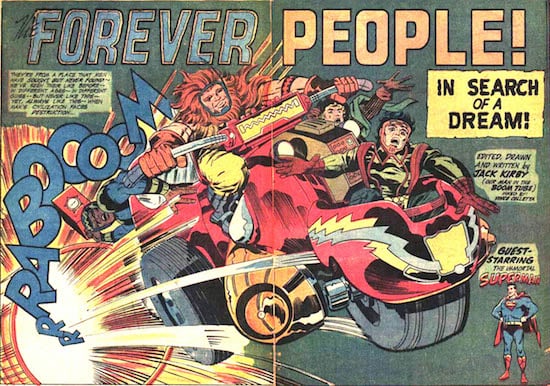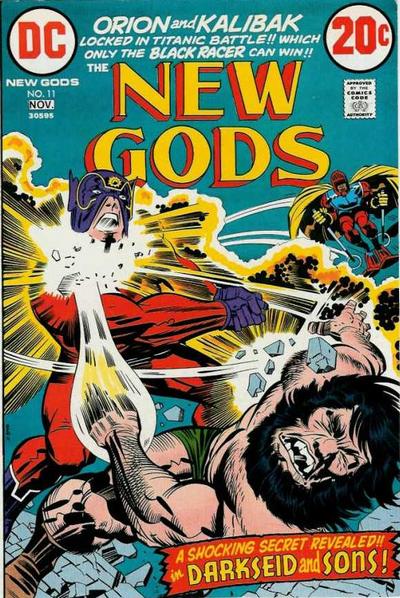Fourth World (2)
By:
July 22, 2014
Second post in a series of five, by Adam McGovern, revisiting four decades of Jack Kirby’s “Fourth World” comic-book mythos.
Fourth World, Part 2
In Part 1, we came through Kirby’s battlefields — literal, commercial and pop-cosmic. In Part 2 we open on the culture war surrounding it…

In New Gods and Mister Miracle Kirby was responding to the geopolitical debates and sexual realignments of his day in ways which have maintained, and even gained, relevance. In Forever People he was processing a generational conflict which now seems more than a calendar century ago, but the book’s original innovation should not be overlooked. It is not only the forward-thinking slickness and blockbuster scale of Kirby’s visuals that have made most of the Fourth World date well; it is also the care he took in abstracting his topical allegories enough that they can feel timeless. Forever People was the component most bound to its time in both look and theme, following the odyssey of five younger gods who adopt the accouterments of Earth hippies and seek to subvert Darkseid through peace, love, and free will. Like any responsible hippies, they spent most of their run combating nightmare manifestations of consumer culture and patriarchal authority; antagonists included the hypnotic mass-media evangelist Glorious Godfrey and the Anti-Life-wielding tycoon Billion Dollar Bates, and for several issues the team was tormented in a sadistically refitted amusement park. Though it can seem outmoded now, Forever People was a landmark in mainstream-media sympathy for the counterculture, and indeed central to Kirby’s worldview.
When most people discuss the Fourth World they’re thinking of its centerpiece, The New Gods, the battlefield epic whose doomed protagonists did the historical heavy lifting while the milder characters of Mister Miracle and The Forever People escaped quite so much hardship — but carried the equivalent burden of preserving some semblance of civilization. This dynamic corresponded to Kirby’s perception of his own experience in the era of the Depression and World War II. Rather than begrudging the younger generation the easier life that enabled them to wage a different kind of war on convention, Kirby saw their comfort and idealism as making his own sacrifices worthwhile. Amongst the Fourth World’s cast, Kirby is more at ease with the characters the younger they are, from the genocidal Darkseid to the homicidal Orion to the pacifist Forever People (with a special affection for Scott Free’s attempted separate peace).

Though it’s often read as a classic tale of “good vs. evil,” Kirby seems to have seen his saga as a modern one of order vs. free will. In support of the former view, much is made of Kirby’s own encounter with evil as an infantryman in WWII Europe, while less is made of his recorded observations of his comrades’ moral ambiguity and his opponents’ undeniable humanity (and here a digression is necessary to note the uncommon charity of this Jewish private ranging through the Greater Third Reich). Kirby’s recollections broadened his perspective enough to create in the Fourth World a villain (Darkseid) who could be alternately ruthless and sanguine, and a hero (Orion) who could be alternately inspiring and repellent. It was the obliteration of such shades of personality and nuances of observation that Kirby feared most, as embodied in Darkseid’s objectives not of cruelty but control. To Kirby, Darkseid’s antithesis is the independent-minded non-combatants like the Forever People and the youth they represent (and it’s no accident that a nervous Darkseid has more screen time in their series than in the other two combined). The opposite of Hitler was not those who fought him, but a later generation who might be beyond fighting.
Unfortunately, the original Fourth World was not long for this one, and another pop-culture generation would pass before it was fully appreciated. Purportedly low sales scuttled New Gods and Forever People after about two years and 11 issues; Mister Miracle was reprieved until #18, though Kirby would self-consciously abandon its ties to the larger saga until the final issue. Subsequent scholarship suggests that the books were in fact respectably popular but were killed by a combination of editorial over-expectation (DC wanted blockbusters from Kirby and thus ordered up Superman-sized print runs for the untested new series) and third-party speculation (in the infancy of the comic-shop direct market, specialty dealers would manufacture scarcity by buying up much-anticipated comics from distributors before they hit the stands). But the fact remains that sheltering offbeat material ’til it found its audience just didn’t compute with the media corporations of the time, and every innovative comic of the decade, from War of the Worlds to Howard the Duck, enjoyed a shorter lifespan than its creators intended. In the view of many, this left the Fourth World, as Kirby biographer Mark Evanier puts it, “comics’ great unfinished symphony.”

Maybe, maybe not. Kirby’s public craved a resolution of the cosmic-war plotline, but in a move probably more indicative of his principal interests, he wrapped the three series up not with grand finales but on emotional beats: Orion accepts the reality that he is his worst enemy’s son and becomes at peace with his conflicted nature (if resolved to an eventual confrontation that he might not survive); Scott weds Barda, thus holding out the hope of reconciliation between their two societies; the Forever People are banished to an unspoiled faraway planet by Darkseid, removing their inconvenient spontaneity from his authoritarian plans while also delivering them to a world which finally suits their ideals. At the end of Mister Miracle, the last branch of the trilogy to go, Darkseid, who has disrupted the wedding but failed to stop love’s power, remarks on this partial victory that “Life, at best, is bittersweet,” and bursts into rueful but full laughter — a conclusive enough credo for the cycle’s ever-game though often-disappointed creator.
End Part 2 — be here tomorrow as the exodus of the gods begins in Part 3!
ALL INSTALLMENTS IN THIS SERIES
ALSO CHECK OUT: Jack Kirby as HiLo Hero by David Smay | Douglas Rushkoff on THE ETERNALS | John Hilgart on BLACK MAGIC | Gary Panter on DEMON | Dan Nadel on OMAC | Deb Chachra on CAPTAIN AMERICA | Mark Frauenfelder on KAMANDI | Jason Grote on MACHINE MAN | Ben Greenman on SANDMAN | Annie Nocenti on THE X-MEN | Greg Rowland on THE FANTASTIC FOUR | Joshua Glenn on TALES TO ASTONISH | Lynn Peril on YOUNG LOVE | Jim Shepard on STRANGE TALES | David Smay on MISTER MIRACLE | Joe Alterio on BLACK PANTHER | Sean Howe on THOR | Mark Newgarden on JIMMY OLSEN | Dean Haspiel on DEVIL DINOSAUR | Matthew Specktor on THE AVENGERS | Terese Svoboda on TALES OF SUSPENSE | Matthew Wells on THE NEW GODS | Toni Schlesinger on REAL CLUE | Josh Kramer on THE FOREVER PEOPLE | Glen David Gold on JOURNEY INTO MYSTERY | Douglas Wolk on 2001: A SPACE ODYSSEY | Joshua Glenn on Kirby’s Radium Age Sci-Fi Influences | Chris Lanier on Kirby vs. Kubrick | Scott Edelman recalls when the FF walked among us | Adam McGovern is haunted by a panel from THE NEW GODS | Matt Seneca studies the sensuality of Kirby’s women | Btoom! Rob Steibel settles the Jack Kirby vs. Stan Lee question | Galactus Lives! Rob Steibel analyzes a single Kirby panel in six posts | Danny Fingeroth figgers out The Thing | Adam McGovern on four decades (so far) of Kirby’s “Fourth World” mythos | Jack Kirby: Anti-Fascist Pipe Smoker
ALSO ON HILOBROW: HiLobrow posts about comics and cartoonists, and science fiction
MORE POSTS by ADAM McGOVERN: OFF-TOPIC (2019–2025 monthly) | textshow (2018 quarterly) | PANEL ZERO (comics-related Q&As, 2018 monthly) | THIS: (2016–2017 weekly) | PEOPLE YOU MEET IN HELL, a 5-part series about characters in McGovern’s and Paolo Leandri’s comic Nightworld | Two IDORU JONES comics by McGovern and Paolo Leandri | BOWIEOLOGY: Celebrating 50 years of Bowie | ODD ABSURDUM: How Felix invented the 21st century self | CROM YOUR ENTHUSIASM: C.L. Moore’s JIREL OF JOIRY stories | KERN YOUR ENTHUSIASM: Data 70 | HERC YOUR ENTHUSIASM: “Freedom” | KIRK YOUR ENTHUSIASM: Captain Camelot | KIRB YOUR ENTHUSIASM: Full Fathom Five | A 5-part series on Jack Kirby’s Fourth World mythos | Reviews of Annie Nocenti’s comics Katana, Catwoman, Klarion, and Green Arrow | The curated series FANCHILD | To see all of Adam’s posts, including HiLo Hero items on Lilli Carré, Judy Garland, Wally Wood, and others: CLICK HERE
